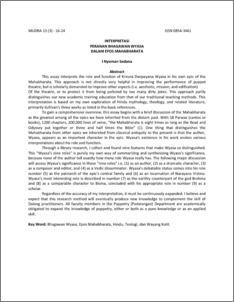I Nyoman, Sedana
(2003)
INTERPRETASI PERANAN BHAGAWAN WYASA DALAM EPOS MAHABHARATA.
Mudra (JURNAL SENI BUDAYA), 13.
p. 1.
ISSN 0854-3461
![[img]](http://repo.isi-dps.ac.id/style/images/fileicons/application_pdf.png)  Preview |
|
PDF (INTERPRETASI PERANAN BHAGAWAN WYASA DALAM EPOS MAHABHARATA)
- Submitted Version
Download (274kB)
| Preview
|
Abstract
Abstract
This assay interprets the role and function of Kresna Dwipayana Wyasa in his own epic of the Mahabharata. This approach is not directly very helpful in improving the performance of puppet theatre, but is scholarly demanded to improve other aspects (i.e. aesthetic, mission, and edification)
Of the theatre, or to protect it from being polluted by too many dirty jokes. This approach partly distinguishes our new academic training education from that of our traditional teaching methods. This interpretation is based on my own exploration of Hindu mythology, theology, and related literature, primarily Sullivan’s three works as listed in the book references.
To gain a comprehensive overview, this essay begins with a brief discussion of the Mahabharata as the greatest among all the epics we have inherited from the distant past. With 18 Parwas (cantos or books), 1200 chapters, 200,000 lines of verse, “the Mahabharata is eight times as long as the Ilead and Odyssey put together or three and half times the Bible” (1). One thing that distinguishes the Mahabharata from other epics we inhereted from classical antiquity to the present is that the author, Wyasa, appears as an important character in the epic. Wyasa’s existence in his work evokes various interpretations about his role and function.
Through a library research, i collect and found nine features that make Wyasa so distinguished. This “Wyasa’s nine roles” is purely my own way of summarizing and synthesizing Wyasa’s significance, because none of the author tell exactly how many role Wyasa really has. The following major discussion will assess Wyasa’s significance in those “nine roles” i.e. (1) as an author, (2) as a dramatic character, (3) as a composer and editor, and (4) as a Vedic disseminator. Wyasa’s debatable status comes into his role number (5) as the patriarch of the epic’s central family and (6) as an incarnation of Narayana Vishnu. Wyasa’s most interesting role is described in number (7) as the earthly counterpart of the god Brahma and (8) as a comparable character to Bisma, concluded with his appropriate role in number (9) as a scholar.
Regardless of the accuracy of my interpretation, it must be continuously expanded. I believe and expect that this research method will eventually produce new knowledge to complement the skill of Dalang practitioners. All faculty members in the Puppetry (Pedalangan) Department are academically obligated to expand the knowledge of puppetry, either or both as a pure knowledge or as an applied skill.
Actions (login required)
 |
View Item |


